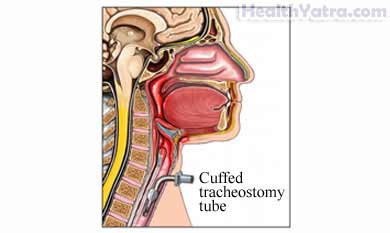Definition
Tracheotomy is the surgical creation of an opening from the outside of the neck into the windpipe. A tube is inserted into the opening to allow for normal breathing. It is done to bypass obstructions that are interfering with breathing. The opening is called a stoma or tracheostomy. A stoma may be either temporary or permanent.
In an emergency, a cricothyroidotomy may be done. This type of airway should only be used temporarily. If the airway will be needed for more than 48 hours, a standard tracheotomy will be done.

Reasons for Procedure
A tracheotomy is used to create an open airway. It is done to restore normal breathing in the following situations:
- The airway is obstructed at or above the level of the larynx (voice box), due to:
- Trauma to the neck area
- Obstructing tumors in the upper airway
- Respiratory failure requiring long-term mechanical breathing assistance, as in these cases:
- Spinal cord injury in the neck area
- Severe lung infection or inflammation
- Injury to the respiratory tract due to breathing in smoke or steam or inhaling corrosive substances
- Birth defects of the trachea or larynx
- Foreign object blocking the trachea or larynx
- Severe sleep apnea
Possible Complications
If you are planning to have a tracheotomy, your doctor will review a list of possible complications, which may include:
- Bleeding
- Infection
- Damage to the vocal cords, vocal cord nerves, or esophagus
- Damage to the lungs
- Difficulty swallowing
- Low blood pressure
- Tracheostomy tube displacement or damage
- Scarring at the site of operation leading to closure of the tracheostomy
Some factors that may increase the risk of complications include:
- Age: infants and elderly adults
- Obesity
- Smoking
- Poor nutrition
- Recent illness, especially an upper-respiratory infection
- Alcoholism
- Long-term illnesses
- Use of certain prescription and nonprescription drugs
What to Expect
Prior to Procedure
Your doctor will likely do the following:
- Chest x-ray —a test that uses radiation to take a picture of structures inside the body
- Blood and urine tests
- Review of medicines
Talk to your doctor about your medicines. You may be asked to stop taking some medicines up to one week before the procedure, like:
- Aspirin and other nonsteroidal anti-inflammatory drugs (eg, ibuprofen , naproxen )
- Blood-thinning drugs, such as warfarin (Coumadin)
- Anti-platelet drugs, such as clopidogrel (Plavix)
Anesthesia
General anesthesia will be used. You will be asleep. In emergency situations, local anesthesia may be used. It will numb the area.
Description of Procedure
A cut will be made in the skin of the neck. A section at the front of the windpipe will be removed. A tracheostomy tube, which will act as the airway, will then be fitted into this opening in the windpipe. The skin will be closed around the tube with stitches or clips.
You will breathe through this tube as long as it is in place. Oxygen and machines to assist breathing will be provided, if needed.
You will not be able to speak when the tube is in place unless you put a finger or other covering over the tube. This is because all the air going in and out of the tube bypasses the vocal cords.
Immediately After Procedure
A chest x-ray may be needed.
How Long Will It Take?
About 15-30 minutes
How Much Will It Hurt?
Anesthesia prevents pain during the procedure. You may have some pain and soreness during recovery. Your doctor can prescribe pain medicine to help relieve this discomfort.
Average Hospital Stay
The length of stay will depend on the reason for the procedure. Most stays are 1-5 days.
Post-procedure Care
- Keep the stoma area clean. Clean it daily with mild soap and water or with hydrogen peroxide. Replace the dressing with a clean dry one.
- Ask your doctor about when it is safe to shower, bathe, or soak in water.
- Learn the proper daily care of your tracheostomy tube . This will help maintain its function. Care includes the following, which you will be taught shortly after the surgery:
- Cleaning the tube
- Suctioning the tube regularly to keep it from becoming blocked with secretions
- Humidifying the air you breathe
- Covering the tracheostomy hole with a scarf or other cloth when going outside, so that dust, dirt, and other foreign particles cannot get in
- Being very cautious about breathing in water or small particles through the tracheostomy (such as food bits, powders, aerosol sprays, dust)
- Covering the tracheostomy hole with your fingers in order to speak
- Consult a speech therapist if recommended by your doctor.
- Take antibiotics, if prescribed by your doctor.
- Return to daily activities and work as soon as possible to promote healing.
- Avoid vigorous exercise for six weeks after surgery.
- Be sure to follow your doctor’s instructions.
Once a tracheostomy tube is in place, you will experience breathing and vocal changes. It usually takes three days to adjust to breathing through the tube. Speaking is often a larger adjustment. Initially, you may not be able to speak.
Call Your Doctor
After you leave the hospital, contact your doctor if any of the following occurs:
- Signs of infection, including cough, excessive foul-smelling mucous, fever, and chills
- Redness, swelling, increasing pain, excessive bleeding, or any discharge from the incision site
- Nausea and/or vomiting that you cannot control with the medicines you were given after surgery, or which persist for more than two days after discharge from the hospital
- Pain that you cannot control with the medicines you have been given
- Cough, shortness of breath, or chest pain
- New, unexplained symptoms
- Tracheostomy tube falls out and you cannot replace it–Call for medical help right away.
In case of an emergency, call for medical help right away.
